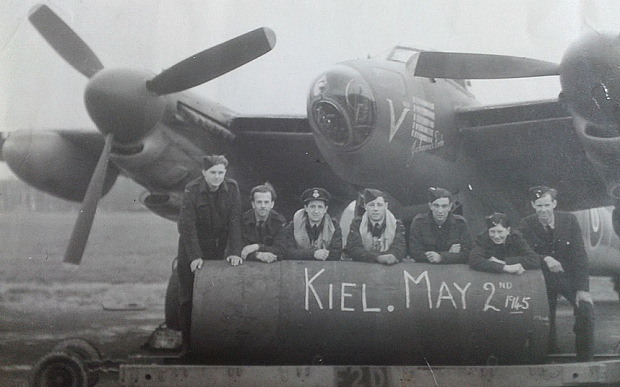
A historic photograph has been discovered of the final Royal Air Force Bomber Command crew minutes before they were due to depart on their last bombing mission at the end of World War Two.
The photograph shows seven aircrew standing in front of the bomb they are about to fly and drop over Nazi Germany in 1945. At the time the photograph was taken they wouldn’t have known that this was to be their last and final bombing raid against the fascist Nazis.
The photograph was taken just before the crew were about to load the bomb onto the RAF Mosquito aircraft. It was later flown to the north of Germany and dropped on Kiel. The bomb was dropped just six days before VE Day.
One of the crew in the photograph is Edward Emsley and it was his son Brian Emsley who found the photograph as he was going through some of his late father’s belongings. Edward died more than 30 years ago, and never spoke of the photograph to his family before he died.
Edward was an aircraftman in the Bomber Command squadron and had also worked in the factory that built the RAF Mosquito aircraft.
Brian, who is now 64, says that he wishes he could have talked to his dad about the photograph and recalls how he was always proud of the Mosquito and his role in making it fly during the war.
Brian believes that this is as close as anyone will get to being one of the last bombing raids on Germany during the war. The RAF’s Air Historical Branch has seen the photographed and has confirmed that the bombing raid on Kiel was Bomber Command’s final bomb drop before the war ended.
Brian says that while his father didn’t condone violence, he also didn’t like the dictatorship and oppression of Nazi Germany. By the time the last Bomber Command bomb had been dropped on Kiel, Hitler had already committed suicide and the end of the war was just days away.
The decision to make the final bomb drop was made, because Allied military chiefs believed Nazi troops were planning to make an advance up to Norway from Kiel, mainly to escape the incoming Allied and Soviet advancement from the East and West. The bomb stopped that from happening.
A whole squadron of Mosquitos took part in the raid, damaging airbases on the outskirts of Kiel, as well as bombing its sea port. The city was occupied by Allied ground troops two days later, the Mail Online reports.
Finally, on 2nd May 1945 German military commanders signed their unconditional surrender.